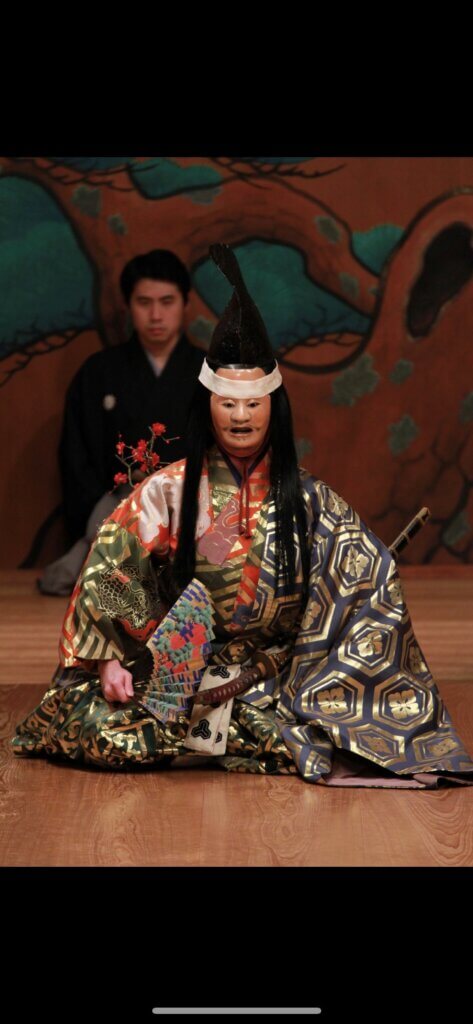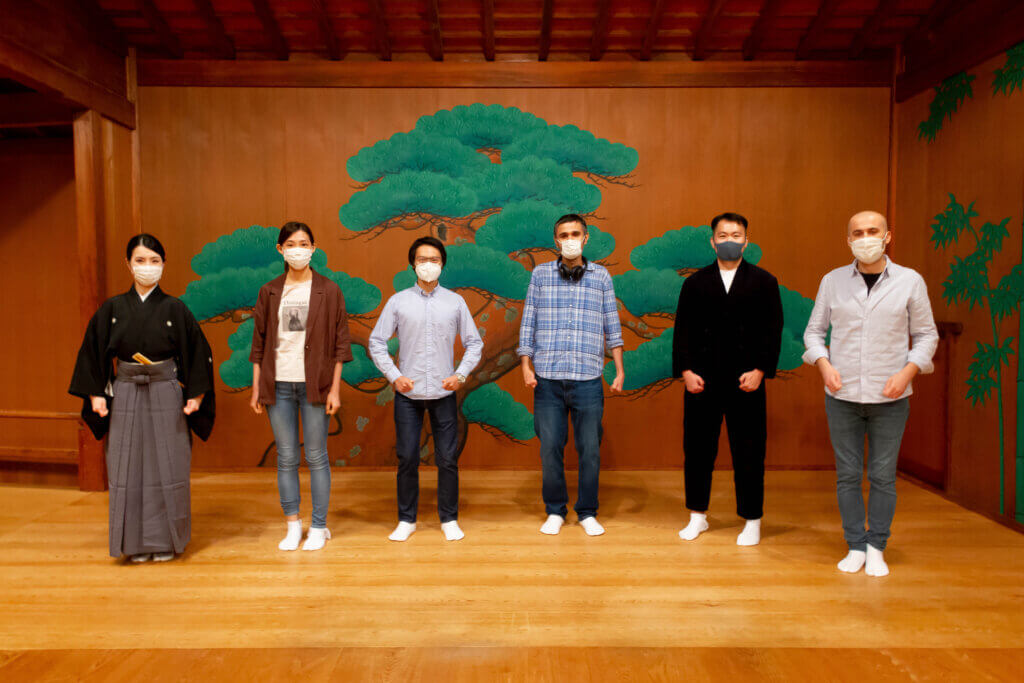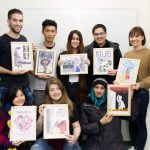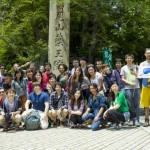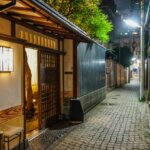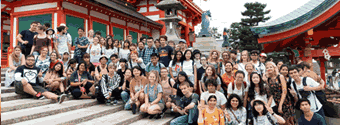能の舞台鑑賞&体験会 Kudan students experienced “Suriashi” of Noh.
Category: Activity report, Diary, Information, Japanese Culture
皆さん「能(のう)」は観たことがありますか? 歌舞伎が有名ですけど、能の方が歴史は古く、日本の伝統芸能の1つです。
動画の編集が終わらず、ブログを書き終わるのに時間がかかってしまったのですが、能楽師の武田 伊佐さんにお声をかけて頂き、学校近く、水道橋駅のすぐ近くにある「宝生能楽堂(ほうしょうのうがくどう)」まで、在校生・卒業生数人と能の舞台を観に行きました。
Have you ever seen “Noh” before? Kabuki might be more popular, but Noh is the oldest Japanese theatrical art. It took some time to post this blog beacause of editting the videos. Sorry. The Noh player, Ms.TAKEDA ISA invited kudan students to their performance which was held in HOSHO NOHGAKUDO in Suidobashi, so I took some kudan students and kudan graduates to the theatre.
素謡(すうた)、舞囃子(まいばやし)などの演目のあと休憩時間に、九段の学生だけ武田さんに解説してもらいました。能は昔の言葉を使うので、日本人であっても事前の資料などを見ていないと内容を理解するのが難しいのです。観客の方も色々資料を個々に用意し、舞台を観ていました。先に説明していただき、資料(英訳付き)ももらったので、内容を理解することができました。
During the break time after the play of SU-UTA and MAI-BAYASHI, Ms.Takeda explained to kudan students about the story of the play which will be performed aftet the break. Many difficult and old Japanese expression was used in the Noh, therefore it will be also difficult to understand for Japanese people without any documents in advance. The other audience were watching the play with some handouts. Ms. Takeda explained about the story and gave us the handouts with English subtitles, so we could understand the story.
今回観たのは「箙(えびら)」というお話。ものすごく簡単に説明すると、旅の途中僧侶が梅の木の下で若武者の霊に出会います。そのやり取りを舞台にしたものです。 ちなみに箙(えびら)というのは矢を入れて背負う道具のことです。
We watached a play called “EBIRA”. In bried, the traveling Buddhist monks meets a ghost of a young warrior under the plum(ume) tree. The play was all about the conversation between the monks and a ghost. Ebira means a quiver for arrows.
能の特徴である「面(おもて)」を付けて演じる主役の方がいます。その主役を「シテ」といいます。相手役の今回は僧侶の役を「ワキ」といいます。
楽器を演奏する方たちの方を「囃子(はやし)」といいます。そして、ワキの後ろには地謡を担当する「地謡(じうたい)」がいました。
能は、幽霊とか神様、鬼などこの世のものではない人が主役「シテ」になることが多いそうです。
シテの相手役である「ワキ」は、旅の僧や神官、武士など、この世で実際に生きている大人の男性として設定されることが多く、実際に生きている人という設定なので面はつけていないことが多いです。
One of particular features of Noh is “Omote(Noh masks)”. The main character will be played by Shite, who mostly appears wearing a mask. Shite means protagonist. (A Noh actor with a main role) The other character will be palyed by Waki who plays an opposite character. In this story of Ebira, the monks will be played by Waki. Those who plays musical instruments is called “Hayashi”. There are also people “Jiutai” who performs utai. The main character “Shite” plays unworldly beings, such as deity, ghost, ogre, etc.
The opposite character “Waki” plays an adult male who actually lives in this world such as a travel monk, Shinto priest, or samurai. Generally he does not wear a mask, because the character is actaully lives in this world, not unworldly beings.
What is “Omote“?
https://www2.ntj.jac.go.jp/unesco/noh/en/masks-costumes/mask.html#a
能を見ると色々な疑問がわいてきます。Watching Noh brings up a lot of questions.
能の面(おもて)をつけていたら、どのぐらい見えるんですか?
あまり見えないそうです。面の隙間から柱を見たり、足袋を履いている足で地面を触り、傷がついていたり、場所によって特徴があるので足の裏でそれを感じながら自分の位置を把握しているそうです。
How much can the actor see when you are wearing a Noh mask?
They cannot see much. The actor see the pillars through the masks, or he can touch the ground with his feet wearing tabi socks, and see if there are any scratches on the ground. He feels it with the soles of his feet to know where he is.
シテの人はずっとシテですか?
色々な役の勉強するのは自由だそうですが、シテ方をすると決めたら、基本はずっとシテ方だそうですよ。
If you are a shite, will you always be a shite?
You are free to study different roles, but if you decide to be a shite, you will basically be a shite all the time.
世襲が多いと言われる能の世界。実は最近は、世襲ではなく、やってみたい!と思った人たちが習って、稽古を重ねて、舞台に立っていることも多いようです。
The world of Noh is said to be full of hereditary succession. In fact, these days, it is not only a hereditary tradition. People who want to try it are learning it, practicing it, and peforming it.
能の歌の部分「謡」、舞の部分「仕舞」などの体験教室があるそうです!今回は九段の学生だけの特別体験授業でしたが、随時体験教室は行っているそうなので、日本人の方も留学生もお稽古に参加することができるそうです!
They have hands-on classes for chanting, the singing part of Noh, and shimai, the dancing part of Noh! This time, it was a speacial trial class only for Kudan students, but I heard that they have trial classes at any time, so both Japanese and International students can participate in the practice!
体験教室の案内はこちら。Details of the class ↓
http://www.hosho.or.jp/class/beginner/
今回の体験教室では、役によって異なる摺り足のやり方を、武田さんに教えてもらいみんなで実際にやってみました。
On this day, Ms.Takeda taught us how to do Suriashi, which varies depending on the role, and we all tried it out for ourselves.
この投稿をInstagramで見る
この投稿をInstagramで見る
姿勢を正しく保ったまま、顔は正面に動かないままというのはとても大変。面があるので、ほとんど見えなくなってしまうし、役によっては重たい衣装を着て、そして長い長い難しいセリフを言わなければなりません。この体験を通して、演じる側、それぞれの役目の大変さを少しでも知ることができ、次回から能を見るときに今までとは違った視点からも観ることができそうです。
It is very difficult to keep your posture correct and your face still in front position. The masks make it almost impossible to see, and depending on the role, you have to wear heavy costumes and say long, difficult lines. Through this experience, we were able to learn a little more about the performers and how difficult each role is, and we will be able to watch Noh from a different perspective the next time we see it.
私は今回、能の舞台を観て、セリフのきっかけを聞き逃さないというのは大変難しいだろうなあと思いました。日本人にとっても能の言葉は古い言い回しの言葉なので、内容の理解も難しいです。だから余計に、セリフのタイミング、演奏のタイミングを逃さないようにするのは、とても難しそうだなあとみていましたが皆さんたくさんお稽古をするので、できるんだと思います。能は衣装やそれぞれの役割などにも注目してみると、さらに面白いなあと、発見でした。
Watching the Noh play this time, I realized that it must be very difficult to not miss the chance to say the lines. Even for Japanese people, it is difficult to understand the content of Noh because it is an old-fashioned language. That’s why I thought it would be very difficult to keep up with the timing of the lines and the performance, but I think everyone can do it because they practice a lot. I also discovered that Noh is even more interesting when you pay attention to the costumes and the roles of each actor.
学生たちからは、「面白かった!」とか「お面と目が合って、怖かった」「楽器の演奏も素敵だった」などいろいろな感想をもらいました。
日本人であっても能の舞台に上がれることなんてありません。本当に貴重な体験をさせてもらいました。
ぜひまた体験したいですね!
We received various comments from the students, such as “It was interesting! or “It was scary because my eyes met the mask.” or “The instrumental performance was wonderful. ”
Even if you are Japanese, you will never be able to go up on a Noh stage. It was a really valuable experience for us. We’d love to experience it again!
英語で能について説明しているページを見つけたので紹介しておきます。
Explanation about Noh in English will be this website.
https://www2.ntj.jac.go.jp/unesco/noh/en/
More from my site
- Closed Student Visa applications for October 2025.
- Student visa| Kudan Japanese Institute Tokyo
- 受理結束2025年10月留學簽證申請。
- 留學簽證手續| 日本語學校、到東京留學的話、九段日本語學院就對了
タグ: japanesecultureexplerience, NOH, 宝生流, 宝生能楽堂, 日本文化体験, 能, 能体験
2021年12月21日 火曜日 6:16 PM Category: Activity report, Diary, Information, Japanese Culture.



